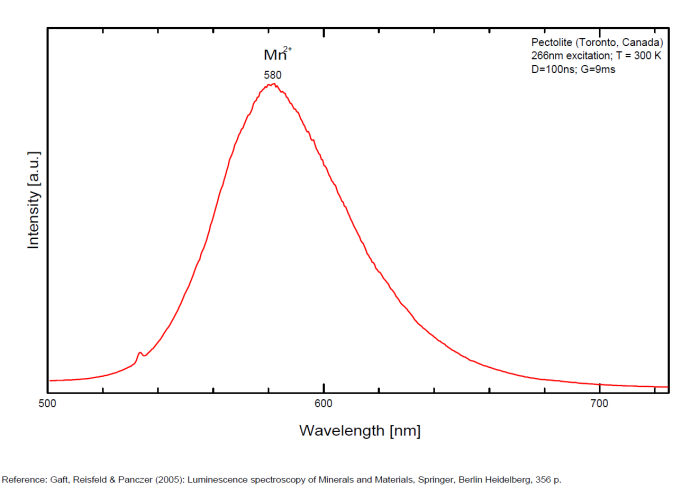Database of luminescent minerals
PECTOLITE
Chemical formula: NaCa2Si3O8(OH)
Family: Silicates
Status: IMA-GP
Crystal system : Triclinic
Display mineral: NON
Associated names (luminescent varieties, discredited names, synonyms, etc.): pecto-prehnite, larimar,
Luminescence:
Longwave UV (365nm) colors: |
Yellowish White , White , Bluish White , Yellowish White , Pinkish White , Pale Yellow , Orangy yellow , Orange , Dark Orange /Tawn , Violet red , Violet Pink , Greenish white , Yellowish , | ||
Intensity LW:Strong | |||
Midwave UV (320nm) colors: |
Pink , Orangy yellow , Orange , Violet red , Violet Pink , | ||
Intensity MW:Strong | |||
Shortwave UV (254nm) colors: |
Orange , Bluish White , Yellowish White , Pale Yellow , Orangy yellow , Orange , Dark Orange /Tawn , Violet red , Violet Pink , Greenish white , | ||
Intensity SW:Weak | |||
Daylight picture
Shortwave (254nm) picture

PECTOLITE under UVSW
Photo and Copyright: James Hamblen
Site of the author
Used with permission of the author
Pictures Galery:

 ...
...Do you have a photo of this mineral you would like to see in the gallery? Contact us!
Phosphorescence (in the common sense of the term) observable with the naked eye:
No data
Triboluminescence: OUI
Thermoluminescence: OUI
Comments:
Luminescence of pectolite was noted in 1903 by Kunz and Baskerville. In Mt-St-Hilaire, Pectolite could be confused with Makatite. The major distinguishing feature is the fluorescence. While not all makatite fluoresces, when it does it is moderate to strong blueish white or very pale greenish SW (and sometimes LW as well) and pectolite is fluorescing in pink or orange.
Activator(s) and spectrum:
Activator(s): Mn2+ , Cr3+, Fe3+, Nd3+,
Peaks in the spectrum (nm):
Mn2+ replacing Ca2+ : 580 - 590 - 610nm ( Paterson NJ, USA sample, exc. 532nm) Fe3+ : 722nm (Asbestos Canada sample, exc. 532nm) Nd3+ : 867, 877, 881, 890, 918nm (Mt St Hilaire Canada sample, exc. 780nm) OH : 652nm (Diako, Sandare District, Mali sample, very sharp peak, exc. 532nm) (Gaft)

Spectrum: Michael Gaft, Petah Tikva, Israel. Plot: Institute of Mineralogy, University of Vienna, Austria, with permission of the authors.
Comments on spectrum and activators:
Activator: probably Mn2+ substituting to Ca2+ (see Gorobets)
Best localities for fluorescence (*):
- Franklin, New Jersey, USA (orange SW+LW);
- Bergen Hill, NJ, USA;
- Lake County, California, USA;
- Jeffrey Quarry, Asbestos, Richmond County, Canada (bright orange LW);
- Poudrette quarry, Mont Saint-Hilaire, La Vallée-du-Richelieu RCM, Montérégie, Québec, Canada (magenta pink LW+SW);
- Langesundfjord, Larvik Plutonic Complex, Norway (yellowish white SW);
- Lower New Street, Paterson, Passaic county, New Jersey, USA (orange LW, pink SW);
- Ilimaussaq complex, Kvanefjeld, Narsaq, Kitaa (West Greenland) Province, Greenland;
- Wessels Mine, Hotazel, Kalahari manganese field (KMF), Northern Cape Province South Africa (intense SW, weaker LW, associated with sugilite);
- Apatitovaya Mt., Khibiny massif, Kola peninsula, Russia (yellow-orange);
- Kookisvumchorr Mt, Khibiny Massif, Murmansk Oblast, Russia (orange-red LW)
(*)The data are not exhaustive and are limited to a few remarkable localities for fluorescence
Bibliographic reference for luminescence:
- The Henkel Glossary of Fluorescent Minerals, Dr. Gerhard Henkel, Published by the FMS, 1989 ,
- Fluorescence: Gems and Minerals Under Ultraviolet Light, Manuel Robbins, 1994, Geoscience Press, ISBN 0-945005-13-X ,
- The World of Fluorescent Minerals, Stuart Schneider, Schiffer Publishing, 2006, ISBN 0-7643-2544-2 ,
- Luminescence Spectroscopy of Minerals and Materials, M. Gaft, R. Reisfeld, G. Panczer, Springer Editor, ISBN: 10 3-540-21918-8 ,
- Luminescent Spectra of Minerals, Boris S. Gorobets and Alexandre A. Rogojine, Moscow, 2002 ,
- Mt St Hilaire Website: http://www.saint-hilaire.ca ,
- Handbook of Fluorescent Gems and Minerals, a practical guide for the gem and mineral collector, Jack de Ment, 1949 ,
Reference for luminescence on the Internet:
- The Langesundsfjord: history, geology, pegmatites, minerals, Alf Olav Larsen, Bode Verlag Gmbh, 2010 ISBN 978-3-925094-97-2
- Laser-induced fluorescence and thermoluminescence response of a Na-Ca rich silicate CORRECHER V., GARCIA-GUINEA J., CASTILLEJO M. , OUJJA M., REBOLLAR E., LOPEZ-ARCE P. , Radiation Measurement, 2006, vol. 41, no 7-8 (318 p.)
- Der Aufschluss, Vol.48, n°2 March/April 1997 Langban minerals by Fritz Blatter;
- MONT-SAINT-HILAIRE, History, Geology, Mineralogy, Laszlo HORVATH, The Canadian Mineralogist, Special Publication 14, 2019
Mineralogical reference on the Internet:
 http://www.mindat.org/show.php?name=Pectolite
http://www.mindat.org/show.php?name=Pectolite
 http://webmineral.com/data/Pectolite.shtml
http://webmineral.com/data/Pectolite.shtml
Internet Search:
 Image search on 'Google Images'
Image search on 'Google Images'
 Search for documents in all languages on Google
Search for documents in all languages on Google
A request providing no result means only that no such reference exists in the database, but it does not mean that what you are looking for does not exist, just not to our knowledge. If you think you have found an error or omission, please let us know via the contact page being sure to cite the source of information.

